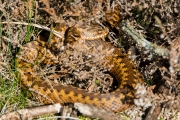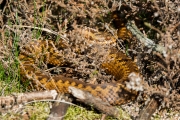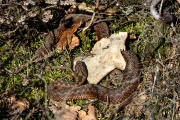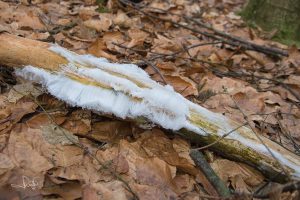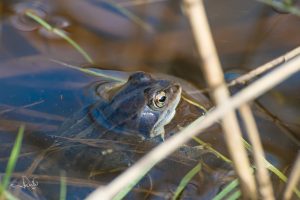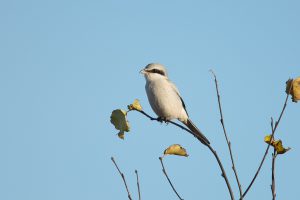Recently I was on the Ballooërveld, a beautiful nature reserve in the province of Drenthe in the northern part of the Netherlands. The Ballooërveld is part of the streams of the Drentsche Aa, an unique area with 21 villages and hamlets in the midst of agriculture and nature. The Ballooërveld is a heathland, with here and there some small bog pools, pine groves and small sand drifts. The area was already inhabited during the Stone Age and and remains of that period have been discovered.Also burial mounds, an urn field and indications of agriculture from the Iron Age have been found. During the Second World War, the so-called Frieslandriegel was constructed in a part of the Ballooërveld by the Germans. The Frieslandriegel was a defensive wall against allied attacks from the west. After the war, the Dutch Ministry of Defense has used the site for military exercises. There are still tank ditches present that remind of these military activities. Due to the depth and shelter, these ditches deliver completely separate mini-biotopes. In 2006 the Ministry of Defense ceased using the area as a military training ground and transferred it to the Ministry of Agriculture, Nature and Food Quality. Staatsbosbeheer (the Forestry Commission) has managed this 367 hectare area since.
Sunbathing vipers
My visit to the area this time was mainly focused on the adder or viper (Vipera berus), the only venomous snake in the Netherlands. I was there a few weeks earlier, but the vipers sadly didn’t show up back then. On the other hand I saw a few beautiful viviparous lizards (Zootoca vivipara), but more about them in a next blog. This time I left home extra early to be in the area on time. Vipers are cold-blooded animals and don’t have an internal heating system; they need solar heat to warm up. In the early morning they try to pick up the first sunlight and then they literally sunbathe. When it gets really hot, they seek out the shadow to prevent overheating. So in the morning you are more likely to see sunbathing vipers than around noon in a bright sun. At that time they’re already among the heather bushes. And I was lucky, I saw this beautiful female specimen and could photograph her for a while. Not for too long, because I didn’t want to disturb her. You can see if it’s a female by looking at the brown colour and the dark brown stripe. I also saw a male that day. The males are mostly gray with a black back stripe. And the males are smaller than the females. The viper is not that big, about between 50 and 70 centimeters long.
Wet areas
Vipers are mainly found in heathland and moor areas. You can see them in a few areas in the Netherlands. The snake prefer to stay in humid environments, so the presence of water is necessary. Furthermore, it is important that there is sufficient shelter, including dense vegetation. The latter is also important when moving around. The cover of the vegetation offers the snakes several advantages: they can approach prey unseen, it remains invisible to predators and they stay in the shade, preventing overheating.
Red list
During my wanderings about the Ballooërveld I first met two volunteers from the Drents Landschap, the regional organization for nature management. They were also looking for vipers in order to map the population. That’s important, because the viper is an endangered species in the Netherlands. After a small peak in 2014, the numbers fell again to 1994 numbers. The species is listed as vulnerable on the Dutch Red List. The main causes of this decline are habitat fragmentation drainage of moors. The silent endless heathlands of Drenthe have been decimated. What remains is a collection of small areas, which are too small to accommodate a healthy population. Because of their fragmented distribution there is also no possibility that populations can reach each other. In addition to drainage, elevating water levels can also negatively impact vipers. Some well-known areas where vipers occurred were flooded in the last decades of the last century to create “wetlands”. Now a viper likes to have water within reach, but wetlands are a bit too much. Overgrazing also causes problems, because it allows the habitats to become bare and the animals lose their hiding place.
Eat or get eaten
Vipers have a fairly varied diet, but is clearly not a vegetarian. The young mainly eat small invertebrates such as worms and insects, but sometimes also a small lizard. The large adult specimens live almost entirely on vertebrates such as mice, lizards, frogs and young birds. Especially birds with their nests on the ground are not safe. In 2013 Rinus Dilerop, a friend of mine, discovered a case of predation of a nightjar (Caprimulgus europaeus)nest by a viper on the Witterveld nature reserve. With a wildlife camera, he was able to record how the snake swept the nest. The female nightjar did not survive the attack, but fortunately the two youngsters did. From then one raised solely by the male. Rinus also described this story in edition 28 of Drentse Vogels, the magazine of Avifauna Drenthe, a birding association. Incidentally, vipers do not eat so much, only six to ten preys a year. Pregnant females do not seem to eat at all.Vipers are however also eaten by other animals. Among other things, it’s on the menu of wild boar (Sus scrofa), badgers (Meles meles) and polecats (Mustela putorius). But hedgehogs (Erinaceus europaeus) also can eat a viper occasionaly. Furthermore, crows, birds of prey (including the short-toed snake-eagle (Circaetus gallicus) occurring sporadically in the Netherlands) are enemies of the viper. Even the pheasant (Phasianus colchicus) and a loose chicken sometimes want to catch a snatch.
Toxic
As I wrote above, the viper is the only venomous snake that occurs in the wild in the Netherlands. Other snake species that can be found here, such as the smooth snake (Coronella austriaca) and the grass snake (Natrix natrix), are non-toxic. But they do bite, so that’s why you always have to be careful when you walk over the heathland. Vipers will not attack that fast and will rather find a safe spot. And if they’re left alone they won’t do anything. But if it feels threatened or, for example, is picked up or approached too closely, there is a chance that the animal will defend itself by attacking. Although the bite is toxic, there rarely result in fatalities. In the period 1885 up to and including 2005, a total of some 220 cases of viper bites in the Netherlands were registered. Of which three with fatal consequences, the last in 1946. Compared to other venomous snakes, the venom of a viper is relatively harmless to a healthy adult. This doesn’t alter the fact that you must be carefull and always call the emergency number if you are bitten. On the other hand, there will rarely be given an antiserum when you are bitten, because you will certainly be sick of that.
Pieterpad
That day it wasn’t that busy in the field, it was a weekday.It was a very sunny day however and I saw some hikers here and there. Not just walking around like I was. No, they had a clear goal in mind, almost all with the same map in hand. The Ballooërveld is located in the fourth stage of the Pieterpad. That’s a long-distance walking path of 492 kilometers from Pieterburen in the north near the coast of the Waddenzee to the Sint Pietersberg in the southeast of the country near the Belgian and German border. In the middle of the field, a hiker was relaxing in the shade of a tree and I got talking to her. She had taken a few days off to walk at least a part of the Pieterpad. “What are you photographing” was her question. The two cameras that dangled on my side (one with the telephoto lens and one with macro lens) clearly betrayed my intentions. “Oh, vipers”, I answered. This was clearly not what she expected. “Are those here?” she asked, looking around a bit shocked. “Yes, I’ve just seen and photographed one”, and I showed the picture of the female viper I’d made just before. “Are they venomous?” was her next – justified – question, to which I answered in the affirmative. I told her afterwards that the chance she would be bitten was small. As long as she didn’t walk with her shorts between the heather bushes, but stay on the paths. I saw a somewhat reassuring look in her eyes. A little later she walked on, neatly over the sandy path. Still just looking around to see if she did not see a snake in the grass somewhere.
Sources:
- www.ravon.nl
- www.naturetoday.com
- www.wikipedia.nl
- Dillerop R. 2014, European Adder Vipera berus kills adult Nightjar Caprimulgus europaeus, Drentse Vogels 28
This post was originally published in Dutch on April 25th 2018



